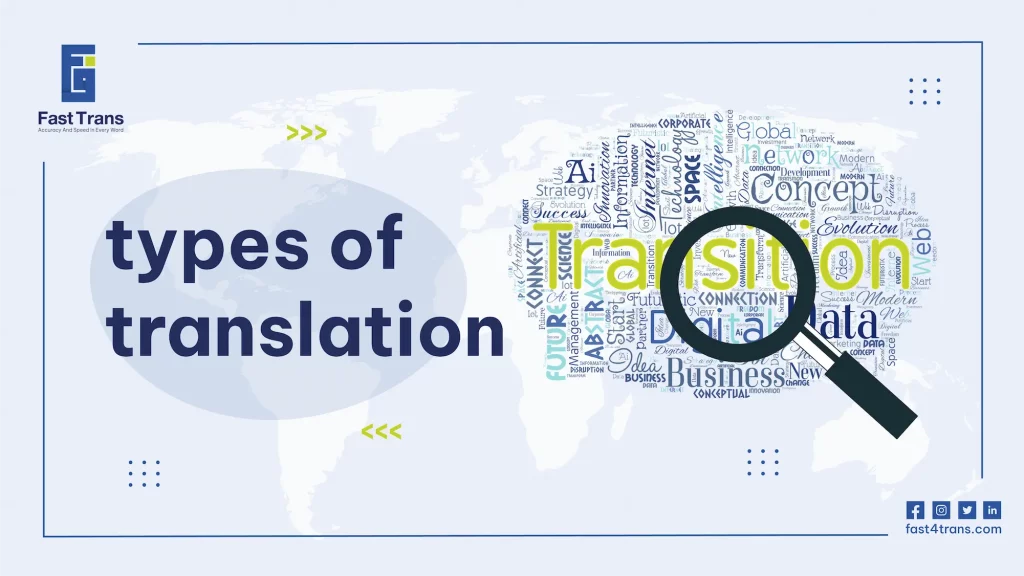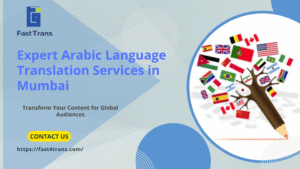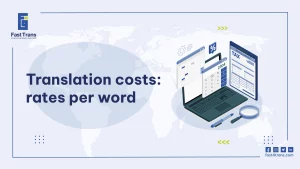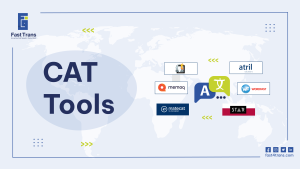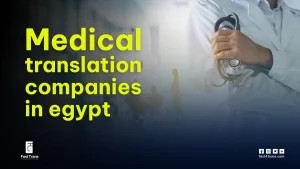Did you know that there are over sixty translation types out there? Some of which are outstanding like culinary, and cryptocurrency translations. Translation, as hundreds of centuries-old practice, is to this day one of the ever-growing fields. Being connected to a diverse range of professions, disciplines, and industries, it is always undergoing additions and alterations that even the experts try hard to keep up with. For ordinary people, it might strike them as new, knowing that when submitting a work to be translated to a professional translation house, it is much more than just word-for-word, sentence-for-sentence, or page-for-page general interpretation.
Types of Arabic Translation covers a wide range of specialized fields, from legal and medical to technical and literary, each requiring expert knowledge and precise use of industry-specific jargon. It extends beyond written texts to spoken and visual forms, including simultaneous translation, sign language, and multimedia content like e-learning and audiovisual translation. With the rise of AI-driven tools and a global demand for culturally accurate and context-sensitive translations, Arabic translators play a key role in industries such as e-commerce, culinary, and finance, ensuring clarity and cultural relevance across diverse audiences.
Modes & Mediums of Translation
Firstly, let’s establish that translation in its basic sense is not only written, but the translated product could be spoken; like in simultaneous translation, and even signed, as in sign language interpretation.
Types of Arabic Translation
Arabic translation services cater to various industries, from general text conversion to specialized fields like legal, medical, financial, and technical content. These services also include journalistic, literary, religious, and multimedia translations, ensuring cultural and linguistic accuracy. Businesses benefit from e-commerce and culinary translation, while AI-driven machine translation is reshaping the landscape with human post-editing for precision.
1. General Arabic Translation
It refers to a wide range of texts that can be translated into Arabic without specialized knowledge in a certain field. General Arabic translators with an excellent command of both Arabic and the source language can be required to translate general documents like manuals, emails, and everyday speech texts.
2. Specialized Arabic Translation
The name is already telling. A specialized Arabic translator can be in great demand from clients and companies because he or she acquires advanced knowledge of the subject at hand while at the same time remaining an experienced translator. One of the primary characteristics of specialized Arabic translation is the use of jargon specific to the field. The diverse fields of specialized Arabic translation could be anything from finance, fashion, sports, media, economics, medicine, science, culinary, and even lesser common fields like archaeology.
3. Legal Arabic Translation
Legal Arabic translation is not only about legal contracts and court documents. It involves a wide range of other documents like birth or marriage certificates. Below the broad type of legal Arabic translation, there are dozens of other sub-types, like international law, legislative, and judicial translations. When looking for different legal Arabic translation services, you’ll find terms like apostille translation, notarization, and sworn translations, where each of them serves a different type of language accuracy and degree of credibility, especially in regard to international documents.
Legal Arabic translation is most known for its sensitivity. For instance, there is a difference between ambiguity found in an electronic machine manual and ambiguity found in a legal Arabic text.
- Judicial Arabic Translation: Encompassing documents like lawsuits, contracts, court documents, and all other documents part of judicial processes.
- NGO and IGO Arabic Translation: Extremely crucial to humanitarian organizations, such as the United Nations, to document press releases, new project information, and ensure their mission is delivered to multinational audiences.
- Arabic Notarization: Refers to the authentication of legal documents in Arabic. A notary is authorized by the government to take note of legal acts in the form of witnessing signatures. A notary has their unique stamp that approves the credibility of an Arabic legal document.
4. Religious Arabic Translation
One of the most important types of Arabic translation. Religious Arabic translation is expansive, not only covering the three Abrahamic religions but also other spiritual doctrines around the world, ancient or contemporary. For instance, religious translators of the Islamic scripture, Quran, can be required to interpret verses, religious sermons, lectures, or other religious books. It is in demand from non-Arabic speakers who are looking for ways to understand the words of Allah without knowledge of the Arabic language.
Like legal Arabic translation, religious texts require a great deal of accuracy, advanced knowledge of the subject, and careful attention to ensure a safe and accurate delivery of meaning across different languages and cultures to avoid ambiguity.
5. Journalistic Arabic Translation
Journalistic Arabic translation is one of the translation types that involves language play and creativity more obviously than the aforementioned ones.
It involves translating anything from news pieces, reports, interviews, and much more into Arabic. In addition to having strong command of both the source language and Arabic, a journalistic Arabic translator keeps in mind the distinct language of the media world that can depart from conventional grammar rules or use emotion and imagination to highlight a certain piece of information in a news article.
A journalistic Arabic translator is a journalist in disguise because he or she is also aware of the surrounding political atmosphere and the sensitivities in the region.
6. Medical Arabic Translation
Given the nature of healthcare literature present in different forms, medical Arabic translation can be highly technical, making it one of the most specialized types of translation. Medical Arabic translators handle academic medical papers, patient records, medical reports, and other educational material.
Are you on the hunt for a professional medical translator? we’ve published a comprehensive article on top medical translation agencies in the MENA.
Read more: What is Cognitive Debriefing?
7. Culinary Arabic Translation
Have you ever picked up a menu at a restaurant and noticed something distinct about how the dishes were named in Arabic? Maybe a traditional dish was named in an odd way, or a foreign dish was transliterated into Arabic. This is the work of culinary Arabic translators, who not only work on food menus but also cookbooks and various kinds of culinary content online, like recipes. Culinary Arabic translation is one of the more interesting types because it is filled with cultural knowledge and, of course, taste!
8. Financial Arabic Translation
Financial Arabic translation is essential for businesses because it deals with sensitive financial information that cannot risk errors. A financial Arabic translator handles financial agreements, tax reports, bank reports, insurance policies, and client meetings.
9. Ecommerce Arabic Translation
Used by businesses to translate their brand identity into Arabic for different target customers. For instance, localizing measurement units or keeping an eye on seasonality. For Arabic e-commerce websites, everything from reviews, landing pages, and product descriptions is also translated.
10. Technical Arabic Translation
Did you ever buy an electronic device, throw away its manual, and then have a hard time trying to figure out how it functions? Well, technical Arabic writing and translation are behind all the user guides and instruction leaflets, in addition to other technical content provided to make life easier for Arabic users dealing with IT, engineering, or manufacturing information. Working as a technical Arabic translator necessitates knowledge of technical jargon and the ability to deliver meaning as simply and coherently as possible.
11. Literary Arabic Translation
The translation of literary works into Arabic involves any text that is considered creative writing. This includes short stories, books, and novels, although some translators argue that poetry is untranslatable, film scripts, or literary essays.
Literary Arabic translation requires a solid understanding of stylistics and the elements of literary genres. A literary Arabic translator has the responsibility to deliver the tone and effect of a literary work to the reader as close as possible to the source text. In this kind of translation, it is possible to find the Arabic target text recrafted better than the source one, owing much to the translator’s creativity and devotion to the comfort and pleasure of the Arabic reader.
Arabic Script Translation: An on-demand derivative of literary Arabic translation. Script translation is crucial nowadays because nearly all films strive to reach a worldwide audience. It involves not only the dialogue but also the transitions, action lines, and, in plays, the stage directions.
Read more: Professional Book Translation
12. Audio-Visual Arabic Translation
Audiovisual content is not limited to films; it includes diverse mediums such as games, advertisements, websites, and eLearning content. This branch of Arabic translation is booming with the increasing demand for video content.
Audiovisual or multimedia Arabic translation has several modes like dubbing, subtitling, surtitling, and voice-over. Therefore, it is a branch that combines technicalities, creativity, and localization.
An audio-visual Arabic translator has a strong background in audio editing software, knows how to preserve the tone and emotional impact of dialogue by consistently looking for language equivalents, while at the same time being extremely careful with cultural sensitivity by avoiding offensive language or hate speech that could be present in a TV show or a game narrative.
Read more: How to translate video from Arabic to English
13. Machine Arabic Translation
More than ever before, artificial intelligence is witnessing its peak, even when it comes to a field as human-dependent as Arabic translation. Over the years, software companies have developed ways to make the process of Arabic translation easier, quicker, and more cost-effective. Now, machine Arabic translation is integrated into anyone’s smartphone and crowned in something like Google Translate.
Due to this, a new role for Arabic translators and linguists has emerged: Machine Translation Post Editing (MTPE). These translators receive the attempted translation of the software and double-check it from various aspects.
Read more: What is social media translation?
What are the most common Arabic translation mistakes?
Common Arabic translation mistakes include literal translation, ignoring gender/number agreement, and misunderstanding context or idiomatic expressions. These errors often arise from a lack of cultural and dialectal awareness, which can distort meaning and impact clarity.
1. Literal Translation
One of the most common mistakes in Arabic translation is the tendency to translate word-for-word or literally from the source language. This approach often results in awkward, unnatural phrasing that does not accurately reflect the intended meaning.
Arabic grammar and sentence structure are quite different from English and other languages, so a direct translation can lead to confusion. For instance, an English sentence like “I am in a hurry” might be translated directly into Arabic as “أنا في عجلة” (Ana fi ajalah), but a more natural translation would be “أنا مستعجل” (Ana mustajil), which better captures the intent.
How to avoid it: Focus on conveying the meaning rather than translating words exactly. Understand the context, idioms, and expressions to ensure that the translation is both accurate and fluent.
2. Misunderstanding Context and Nuances
Arabic is a language rich in contextual meaning. A single word can have multiple meanings depending on the context in which it is used. Misinterpreting the context can lead to incorrect translations. For example, the Arabic word “مفتاح” (miftah) can mean “key,” but in a different context, it might refer to a “solution” or “starting point.”
How to avoid it: Always consider the surrounding text and the cultural or situational context. A thorough understanding of the context in which the word or phrase is used is essential for accurate translation.
3. Gender and Number Agreement
Arabic is a gendered language, meaning that nouns, adjectives, and verbs can change depending on whether they are referring to a male or female subject, or a singular or plural entity. Many translation mistakes occur when translators overlook these agreements.
For example, in Arabic, adjectives must agree in gender and number with the nouns they describe. A mistake like translating “beautiful women” as “جميلة النساء” (jameela al-nisa’) would be incorrect because the adjective “جميلة” (jameela) is singular and feminine. The correct translation would be “جميلات النساء” (jameelat al-nisa’), making the adjective plural to match the plural noun.
How to avoid it: Always double-check the agreement between nouns, adjectives, and verbs in terms of gender and number, ensuring they match the intended meaning of the sentence.
4. Incorrect Use of Pronouns
Pronouns in Arabic can be tricky, as they can change depending on gender, number, and formality. Using the wrong pronoun can significantly alter the meaning of a sentence. For instance, the difference between the pronouns “هو” (huwa, he) and “هي” (hiya, she) is clear, but in some cases, such as with possessive pronouns or reflexive pronouns, confusion can arise.
A common mistake in Arabic translation is not distinguishing between formal and informal pronouns or using the wrong form of a pronoun for politeness. For example, using “أنت” (anta, you) in a formal setting might not be appropriate, and the formal “حضرتك” (hadritak, you) should be used instead.
How to avoid it: Familiarize yourself with the different types of pronouns and their appropriate contexts. Always consider the level of formality and the specific reference.
5. Failure to Translate Idiomatic Expressions
Idiomatic expressions are often the hardest to translate accurately. Phrases like “break the ice” or “a blessing in disguise” make little sense when translated literally into Arabic. Without the proper understanding of cultural equivalents, these idioms can be lost in translation, or worse, lead to confusion.
For instance, the English idiom “it’s raining cats and dogs” would not make sense when directly translated into Arabic. Instead, one might use an expression like “تمطر بغزارة” (tamtr bighazara), meaning “it’s raining heavily.”
How to avoid it: Research idiomatic expressions in both languages and find equivalent phrases that maintain the same meaning and cultural relevance.
6. Ignoring the Dialectal Variations
Arabic is spoken in a variety of dialects, each with its own peculiarities and vocabulary. Dialectal differences can lead to confusion, especially when translating from Modern Standard Arabic (MSA) to local dialects, or vice versa. Misusing a regional term or misinterpreting local expressions can result in an inaccurate or awkward translation.
For example, the word for “bread” in Egyptian Arabic is “عيش” (aish), whereas in Levantine Arabic, it is “خبز” (khobz). If you’re translating for a specific region, using the wrong dialect can be a major mistake.
How to avoid it: Be mindful of the dialect you are translating into and ensure that the vocabulary and expressions are region-appropriate. When working in MSA, recognize that regional dialects may use different words for the same concept.
7. Overlooking Punctuation and Sentence Structure
Arabic punctuation and sentence structure differ significantly from English. Arabic sentences often begin with a verb, and the word order is subject-verb-object (SVO) in some cases but can also be verb-subject-object (VSO). Translators often make mistakes by not adjusting sentence structure when switching between Arabic and English, resulting in awkward phrasing or ambiguity.
For example, a sentence like “She studies medicine” in English could be translated directly to “هي تدرس الطب” (Hiya tadrus al-tibb), but it may be more natural to say “تدرس هي الطب” (Tadrus hiya al-tibb) in certain contexts.
How to avoid it: Understand the basic sentence structure and how it affects the flow and clarity of the translation. Always ensure the punctuation is used correctly according to Arabic conventions.
8. Inadequate Knowledge of Cultural Sensitivities
Language is deeply intertwined with culture, and many words or phrases can carry cultural connotations. What may be considered polite or appropriate in one culture might be seen as offensive or inappropriate in another. A common mistake is to overlook these cultural sensitivities when translating.
For instance, certain colors, symbols, or even numbers may carry different meanings in Arab culture compared to Western cultures. An example is the color green, which has religious significance in many Arab countries and might be considered more than just a color.
How to avoid it: Cultivate an understanding of the cultural context behind the language. This ensures that the translation not only makes sense but also respects local customs, traditions, and taboos.
Conclusion
Types of Arabic Translation spans a wide array of specialized fields, providing services in sectors such as legal, medical, financial, and technical translation. This also includes more creative forms like journalistic, literary, and religious translations, all ensuring linguistic precision and cultural accuracy. Translation for specific industries often involves the use of specialized jargon, such as in legal or medical texts, and requires expert knowledge in each respective field. For example, legal Arabic translation encompasses contracts, court documents, and certificates, while medical Arabic translation deals with clinical reports, academic papers, and patient records.
Furthermore, Arabic translation is not limited to written text but also covers oral and visual mediums, including simultaneous spoken translation, sign language, and audiovisual content. The demand for these services is growing with the rise of multimedia, e-learning, and AI-driven machine translation. Specialized translations, such as those for e-commerce, culinary content, and technical manuals, also require deep understanding of both language and the specific content domain. The field is broad and diverse, catering to different audiences with an emphasis on maintaining cultural relevance and linguistic accuracy.

